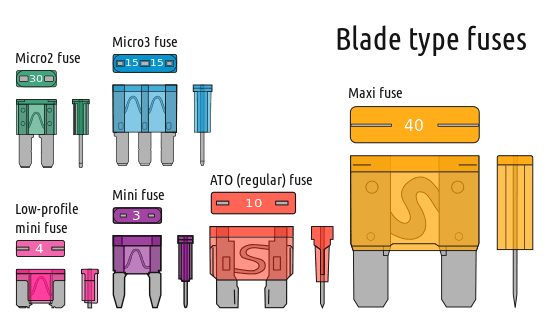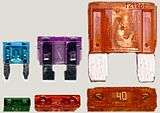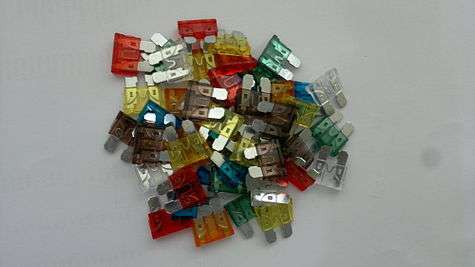Fuse (automotive)

Automotive fuses are a class of fuses used to protect the wiring and electrical equipment for vehicles. They are generally rated for circuits no higher than 24 volts direct current, but some types are rated for 42-volt electrical systems. They are occasionally used in non-automotive electrical products.
Blade type
Blade fuses (also called spade or plug-in fuses), with a plastic body and two prongs that fit into sockets, are mostly used in automobiles. Each fuse is printed with the rated current in amperes on the top. These types of fuses come in six different physical dimensions:
- micro2
- micro3
- low-profile mini (APS),
- mini (APM / ATM)
- regular (APR / ATC / ATO / ATS)
- maxi (APX) heavy-duty.
Unofficially, the APS fuse is sometimes called "micro" since the term means smaller than mini, but recently fuses using the micro name have been released. Regular blade-type fuses, also known as standard fuses, were developed in 1976 for low voltage use in motor vehicles. The mini fuses were developed in the 1990s. Blade type fuses can be mounted in fuse blocks, in-line fuse holders, or fuse clips. The ATC fuse has a fuse element that is closed or sealed inside the plastic housing and the ATO fuse has a fuse element that is open or exposed on the bottom of the fuse between the blades.
Size groups

| Blade Size | Blade Group | Dimensions L × W × H | Common Ratings (Maximum Amperage) |
|---|---|---|---|
| Micro2 | APT, ATR | 9.1 × 3.8 × 15.3 mm | 5, 7.5, 10, 15, 20, 25, 30 |
| Micro3 | ATL | 14.4 × 4.2 × 18.1 mm | 5, 7.5, 10, 15 |
| Low-Profile Mini | APS, ATT | 10.9 × 3.81 × 8.73 mm | 2, 3, 4, 5, 7.5, 10, 15, 20, 25, 30 |
| Mini | APM, ATM | 10.9 × 3.6 × 16.3 mm | 2, 3, 4, 5, 7.5, 10, 15, 20, 25, 30 |
| Regular | APR, ATC (Closed), ATO (open), ATS[1] | 19.1 × 5.1 × 18.5 mm | 0.5, 1, 2, 3, 4, 5, 7.5, 10, 15, 20, 25, 30, 35, 40 |
| Maxi | APX | 29.2 × 8.5 × 34.3 mm | 20, 25, 30, 35, 40, 50, 60, 70, 80, 100, 120 |
Where space permits, a miniature circuit breaker is sometimes used to replace a blade-type fuse in the same fuse holder.
Color coding
Blade fuses use a common coloring scheme for the micro2, micro3, low-profile mini, mini, and regular size fuses, and a partial color similarity with the maxi size fuses. The following table shows the commonly available fuses for each size group.

| Color | Current rating | Micro2 | Micro3 | Low- profile | Mini | Reg | Maxi |
|---|---|---|---|---|---|---|---|
| Dark blue | 0.5 A | | | | | | |
| Black | 1 A | | | | | | |
| Gray | 2 A | | | | |||
| Violet | 3 A | | | | |||
| Pink | 4 A | | | | |||
| Tan | 5 A | | |||||
| Brown | 7.5 A | | |||||
| Red | 10 A | | |||||
| Blue | 15 A | | |||||
| Yellow | 20 A | | |||||
| Clear | 25 A | | Gray | ||||
| Green | 30 A | | |||||
| Blue-green | 35 A | | | Brown | |||
| Orange | 40 A | | | ||||
| Red | 50 A | | | | | | |
| Blue | 60 A | | | | | | |
| Amber/tan | 70 A | | | | | | |
| Clear | 80 A | | | | | | |
| Violet | 100 A | | | | | | |
| Purple | 120 A | | | | | | |
Regular fuses (ATO) rated 0.5 A, 35 A and 40 A are not mentioned in the DIN standards,[2] but are available in some products from Littelfuse, among others.
Bosch type

Bosch type fuses (also known as continental, torpedo, ATS, or GBC type fuses) are used in old (often European) automobiles. The physical dimension of this type of fuse is 6×25 mm with conical ends. Bosch type fuses usually use the same color-coding for the rated current. The DIN standard is 72581/1.
Color coding
| Color | Current rating |
|---|---|
| Yellow | 5 A |
| White | 8 A |
| Red or Green | 16 A |
| Blue | 25 A |
| Grey or Black | 40 A |
Lucas type
Lucas type fuses are used in old British-made or assembled automobiles. The physical length of this ceramic type of fuse is either 1 inch or 1.25 inch, with conical ends. Glass tube fuses have straight ends. Lucas type fuses usually use the same color-coding for the rated current. Lucas fuses have three ratings; the continuous current they are designed to carry, the instantaneous current at which they will fuse, and the continuous current at which they will also fuse. The figure found on Lucas fuses is the continuous fusing current which is twice the continuous ampere rating that the system should be using; this can be a source of confusion when replacing Lucas fuses with non Lucas fuses. The Lucas 1/4" diameter glass tube fuse have a different length as compared to the standard US item. The Lucas 1/4" diameter glass tube fuse is 1 and 5/32" [~29.4 mm] long, while the US standard 1/4" glass tube fuse is 1 and 1/4" [~32.0 mm] long.
Color coding
| Color | Continuous ampere (=rated current) | Instantaneous fusing ampere | Continuous fusing ampere |
|---|---|---|---|
| Blue | 1.5 | 3.5 | 3 |
| Yellow | 2.25 | 5 | 4.5 |
| Red on Yellow | 2.5 | 6 | 5 |
| Green | 3 | 7 | 6 |
| Nut Brown | 4 | 10 | 8 |
| Red on Green | 5 | 12 | 10 |
| Green on Black | 5 | 12 | 10 |
| Red on Brown | 6 | 14 | 12 |
| Light Brown | 7.5 | 18 | 15 |
| Pink | 12.5 | 30 | 25 |
| White | 17.5 | 40 | 35 |
| Purple on Yellow | 25 | 60 | 50 |
| Yellow on Red | 30 | 75 | 60 |
Glass tube type

North-American built automobiles up to 1981 had electrical systems protected by cylindrical glass cartridge fuses rated 32 volts DC and current ratings from 4 amperes to 30 amperes. These are known as "SFE" fuses, as they were designed by the Society of Fuse Engineers to prevent the insertion of a grossly inadequate or unsafe fuse into the vehicle's fuse panel.[3][4] These SFE fuses all have a 1⁄4 inch diameter, and the length varies according to the rating of the fuse.
- A 4 amp SFE 4 fuse is 5⁄8 inch long (the same dimension as an AGA fuse of any rating),
- a 6 amp SFE 6 fuse is 3⁄4 inch long,
- a 7.5 amp SFE 7.5 fuse is 7⁄8 inch long (same as an AGW fuse of any rating),
- a 9 amp SFE 9 fuse is 7⁄8 inch long (same as an AGW fuse of any rating),
- a 14 amp SFE 14 fuse is 1 1⁄16 inch long,
- a 20 amp SFE 20 fuse is 1 1⁄4 inch long (same as an AGC fuse of any rating), and
- a 30 amp SFE 30 fuse is 1 7⁄16 inches long.[3]
There are a number of lookalike fuses which can easily be confused with these. In general this type of fuse will have an "AG" label of some kind, which originally stood for "all glass." There are at least seven different sizes of fuses with a 1/4 inch diameter. The fuses listed are the most common for the size, which is always a fast-acting fuse:
- 1AG size, type AGA, 1 amp to 30 amp, 1/4 inch diameter by 5⁄8 inch long[3]
- 7AG size, type AGW, 1 amp to 30 amp, 1/4 inch diameter by 7⁄8 inch long[3]
- 8AG size, type AGX, 1 amp to 30 amp, 1/4 inch diameter by 1 inch long[5]
- 3AG size, type AGC, 0.125 amp to 50 amp, 1/4 inch diameter by 1 1⁄4 inch long[5]
- UK size, type UK, 35 amp to 50 amp, 1/4 inch diameter by 1 1⁄4 inch long[3]
- 9AG size, type AGY, 50 amp, 1/4 inch diameter by 1 7⁄16 inch long[3]
- 5AG size, type AGU, 1 amp to 60 amp, 13⁄32 inch diameter by 1 1⁄2 inch long.[3] Also called "Midget fuses."[5]
These and other fuses are still being manufactured for many applications, including for AC circuits and DC uses. Some are time delayed, slow reacting, or have leads for terminals used in circuits without a fuse holder.[5][4] Many of the fuse dimensions and characteristics are published by the Society of Automotive Engineers as Standard SAE J 554.
Limiter type
Limiter fuses consist of a metal strip from a lock plate, for currents over 40 amperes. Frequently, these are used in close proximity to starter battery fuse boxes. They are used also in electric vehicles, e.g., in forklift trucks. Because strip fuses require the use of tools for replacement they are therefore legally considered non-serviceable components for end-users.
See also
References
External links
Automotive fuse selection guides
Blade fuses
- Littelfuse Blade Fuses: Micro2, Micro3, Low Profile Mini, Mini, Regular, Maxi
- Cooper Bussmann - Automotive Blade Fuses
- OptiFuse - Automotive Blade Fuses